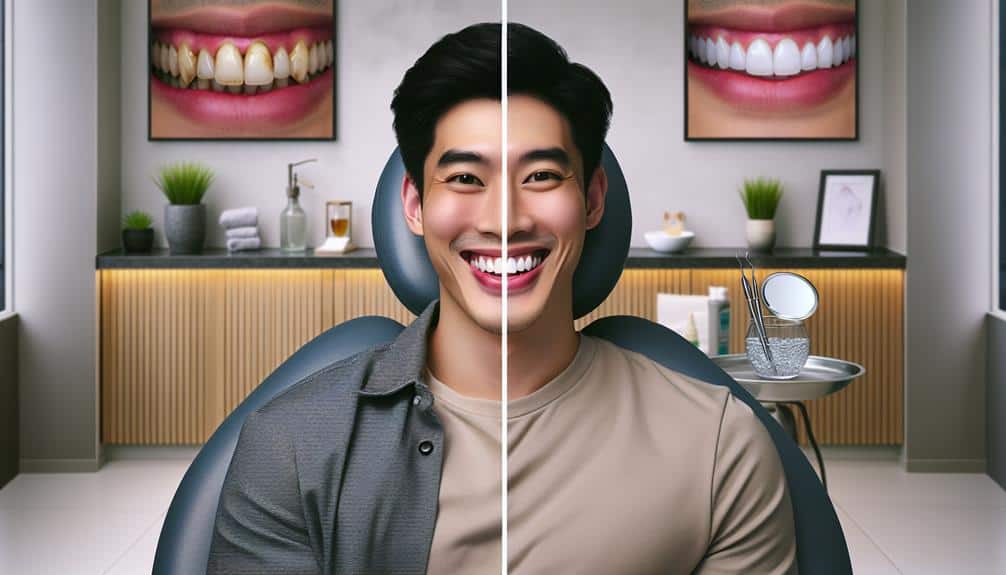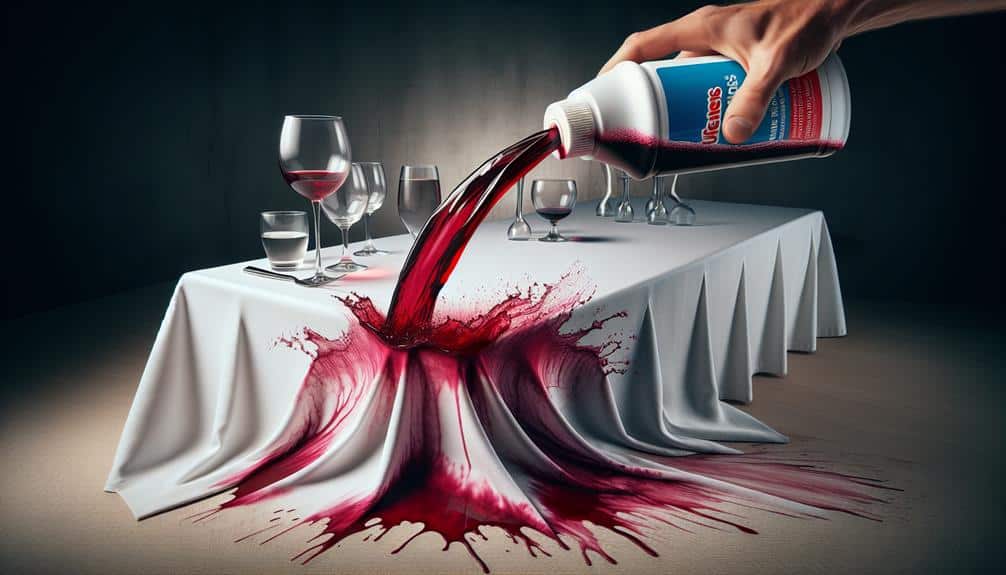To whiten wine-stained teeth, try natural remedies like lemon juice or grape seed extract. Make a paste with baking soda and water for a gentle scrub. Consider charcoal powder for stain removal. Oil pulling with coconut oil can combat staining effectively. Remember, moderation is key to prevent sensitivity. These methods can help restore your smile's natural shine.
Key Points
- Use lemon juice for natural bleaching properties.
- Grape seed extract with antioxidants helps whiten teeth.
- Try strawberry rub as a natural astringent.
- Coconut oil pulling removes stains and plaque.
- Consider chemical-free methods like baking soda paste.
Natural Remedies for Wine Stains
If you're looking to naturally lighten wine stains on your teeth, consider trying these simple remedies. One effective method is using a lemon juice remedy. Lemon juice contains natural bleaching properties that can help reduce the appearance of stains on your teeth. Another option is grape seed extract, which is rich in antioxidants and can aid in combating the discoloration caused by wine.
For a more fruity approach, you can opt for a strawberry rub. Strawberries are known to contain malic acid, which can act as a natural astringent to help remove surface stains on teeth. Additionally, the coconut oil technique is gaining popularity for its teeth-whitening properties. Coconut oil pulling involves swishing oil around in your mouth, which can help remove plaque and brighten your teeth over time.
These natural remedies offer a gentle and chemical-free way to address wine stains on your teeth. Incorporating these methods into your oral care routine may help you achieve a brighter smile.
Hydrogen Peroxide DIY Solutions
Consider incorporating hydrogen peroxide DIY solutions into your teeth-whitening routine for a cost-effective and efficient way to combat wine stains. Hydrogen peroxide is a potent bleaching agent commonly found in teeth whitening products. To make a simple solution at home, mix 1 part 3% hydrogen peroxide with 2 parts water. Use this as a mouthwash, swishing it around for a minute before thoroughly rinsing with water. Be cautious not to swallow the solution.
Another effective method is combining hydrogen peroxide with baking soda to form a paste for brushing your teeth gently. This can help remove surface stains caused by wine consumption. Remember, moderation is key, as excessive use of hydrogen peroxide can lead to tooth sensitivity and gum irritation.
For a more natural approach, consider the lemon juice remedy or the strawberries trick. Lemon juice's citric acid can help lighten stains, but it's crucial to use it sparingly due to its acidic nature. Strawberries contain malic acid, which can also aid in whitening teeth. Crush a strawberry and mix it with a bit of baking soda to create a paste, then apply it to your teeth for a few minutes before rinsing thoroughly.
Baking Soda Paste Method
To effectively utilize the Baking Soda Paste Method for whitening wine-stained teeth, create a paste by mixing baking soda with a small amount of water until it forms a thick consistency. Baking soda is known for its mild abrasive properties that can help remove surface stains on teeth.
Once you have the paste ready, apply it to your teeth using a toothbrush or your finger. Gently brush the paste onto your teeth, focusing on the areas affected by wine stains. Allow the paste to sit on your teeth for about two minutes before rinsing thoroughly.
While the Baking Soda Paste Method can be effective, exercising caution is necessary. Overuse of baking soda can potentially wear down tooth enamel, so limit this method to once or twice a week. Additionally, consider combining the Baking Soda Paste Method with other natural whitening techniques like the lemon juice technique or the strawberry rub approach for enhanced results.
Activated Charcoal Powder Techniques
Activate the power of activated charcoal powder to effectively whiten wine-stained teeth. Charcoal toothpaste benefits from its ability to absorb substances, making it a great choice for removing stains from teeth. When utilizing charcoal powder for teeth whitening, it's crucial to follow proper brushing techniques to maximize its effectiveness.
Here are some tips to help you achieve optimal results:
- Use a soft-bristled toothbrush: Gently brush the charcoal powder onto your teeth to prevent damaging the enamel.
- Brush in small, circular motions: Make sure that the charcoal powder reaches all areas of your teeth for a thorough whitening effect.
- Rinse your mouth thoroughly: After brushing with charcoal powder, ensure to rinse your mouth well to eliminate any residue.
- Limit usage to a few times a week: While charcoal powder can be effective, using it too frequently may wear down the enamel.
Oil Pulling for Teeth Whitening
Utilize oil pulling as a natural method for whitening teeth stained by wine. Oil pulling involves swishing a tablespoon of coconut oil around in your mouth for about 15-20 minutes, then spitting it out. This ancient Ayurvedic practice is believed to help remove bacteria and toxins from the mouth, promoting overall dental hygiene and potentially aiding in teeth whitening.
Coconut oil, with its antimicrobial properties, can help combat bacteria in the mouth that may contribute to staining and plaque buildup. By incorporating oil pulling into your daily dental routine, you may experience a gradual improvement in the whiteness of your teeth over time.
To maximize the benefits of oil pulling for teeth whitening, it's important to continue regular brushing and flossing. While oil pulling can be a beneficial addition to your dental hygiene regimen, results may vary for each individual. Remember to use high-quality coconut oil and practice oil pulling consistently for the best chances of achieving a brighter smile.
Frequently Asked Questions
Are There Any Long-Term Effects on Teeth From Regularly Consuming Wine?
Regularly consuming wine may lead to enamel erosion and increased sensitivity. The acidic nature of wine can weaken tooth enamel over time, making teeth more prone to decay and cavities. Maintaining good oral hygiene is essential to counter these effects.
Can Professional Teeth Whitening Treatments Remove Wine Stains Effectively?
For effective removal of wine stains on teeth, professional teeth whitening treatments are recommended. These treatments can provide quick and noticeable results compared to DIY remedies or over-the-counter products. Consider natural solutions or at-home treatments for maintenance.
How Does Wine Staining Compare to Other Types of Teeth Discoloration?
Comparing wine staining to other discoloration sources is like contrasting a delicate coffee spill to a bold tea stain. Smoking leaves its mark like a permanent ink, while age sprinkles a subtle patina.
Are There Any Specific Types of Wine That Are More Likely to Stain Teeth?
When it comes to tooth color, red wine tends to be more staining than white wine. The pigments in red wine can adhere to enamel, causing discoloration. Being mindful of this can help maintain a brighter smile.
Is It Possible to Prevent Wine Stains on Teeth While Still Enjoying Wine?
To prevent wine stains on teeth while enjoying your favorite reds or whites, consider using preventive measures like drinking water between sips and opting for wine-friendly oral care products. These alternatives can help maintain your smile's brightness.



